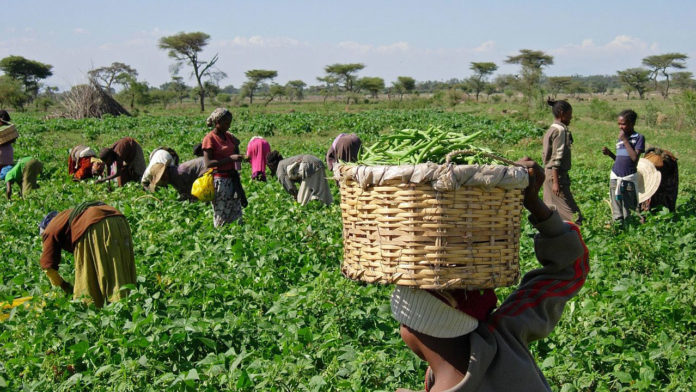by Ummaimah Dikko
The practice of agriculture refers to the cultivation of land and the breeding of animals and plants to provide food, fibres, medicinal plants and other products for the sustenance and enhancement of human life. It can be flawlessly conceived that right from the beginning of time, agricultural practise has been exhibiting an important role in human lives both for the purpose of human survival and for societal development.
Agriculture for that reason has been the key factor in the development and rise of sedentary human civilization, whereby the farming of domesticated species from mostly the rural areas has been creating the food surpluses that enable people to live in the city areas.
No gainsaying, agriculture in Nigeria hovers on the activities of a government office that is responsible for agrarian products development and transformation and currently the Federal Ministry of Agriculture and Rural Development is the organization saddled with this task. Primarily funded by the Federal Government, the Ministry currently superintends over nine parastatals operating as either key departments or agencies across the country.
The Ministry has 2 major departments namely – Technical and Service Departments which comprise of the following units:
• Technical Departments: Agriculture (Trees and Crops), Fisheries, Livestock, Land Resources, Fertilizer, Food Reserve & Storage and Rural Development.
• Service Departments: Finance, Human Resources, Procurement, PPAS (Plan, Policy, Analysis & Statistics) and Co-operatives.
The development of agricultural practise over the years has enabled the human population to grow. It also serves as a branch of the economy in Nigeria, providing employment for about 30% of the population from the latest UNDP Report in 2018. It should be noted that the sector is presently being transformed by commercialization at the small, medium and large-scale enterprise levels and the venture has greatly improved in the past few years because of the advent of technology and other necessary infrastructures.
Initially, most Nigerian farmers merely engage in subsistence farming to provide food for their family while very little is made available in the market. It is always on the go that growth in agricultural output has no doubt been on the rise as farmers are stepping away from subsistence agriculture and embracing modern civilization – investing in large scale farming and ultimately increasing agricultural products.
Over the years, Nigeria depends heavily on the oil industry for its budgetary revenue. it is believed that if the agricultural sector is properly managed and enhanced, it would greatly boost the country’s gross domestic product and even replace oil on the top of the list, considering the vast area of land that is unused in Nigeria. The Nigerian soil and climatic condition is very suitable for the production of wide verities of crops, there are over a hundred different food crops produced by farmers in Nigeria on yearly basis which includes yam, maize, millet, sorghum, beans, potatoes, rice, onions, garbage, carrot, pear, cocoa, cocoa yam, okra, groundnuts, gum – arabic, kolanut, melon, palm kernels, palm oil, plantains, rubber, vegetables and very many others.
The country’s agricultural products fall into two main groups: food crops produced for home consumption, and exports. Prior to the Nigerian civil war, the country was self-sufficient in food, but increased steeply after 1973. Bread made from American wheat replaced domestic crops as the cheapest staple food. Between 1980 to 2016, Yam production increased from more than 5 million tonnes to 44 million tonnes. Here is a chart of some food produced from 1980 to 2016;
Tonnes produced in 1980 2000 2016
5,750,000 8,220,000 7,817,207
Cocoa
153,000 338,000 236,521
Groundnut
471,000 2,901,000 3,028,571
Kola nut
135,000 82,000 143,829
Ginger
200 98,000 522,964
Maize
612,000 4,107,000 764,678
Millet
2,824,000 5,814,000 1,468,668
Guinea Corn
3,690,000 7,711,000 6,939,335
Yam
5,250,000 26,210,000 44,109,615
Cassava
11,500,000 32,697,000 57,134,478
Rice, paddy
1,090,000 3,298,000 6,070,813
Melon seed
94,000 345,000 569,398
Cocoyam
208,000 3,886,000 3,175,842
Sesame seed
15,000 72,000 460,988
In 1990, it was speculated that about 82 million hectares out of Nigeria’s total land area of 91 million hectares were found to be arable, and merely 42 percent of this cultivable area was farmed. Much of this land was farmed under the bush fallow system, a process whereby land is left idle for a period of time to allow natural regeneration of soil fertility and replacement of soil nutrient. The usage of inorganic fertilizers was promoted by Nigerian government in the 1970s. 18 million hectares were classified as permanent pasture, but had the potential to support crops. Most of the 20 million hectares covered by forests and woodlands are believed to have agricultural potential.
It has come to our knowing that Agricultural holdings are small and scattered, and farming is carried out with simple tools. Large-scale agriculture is not common. Agriculture contributed 32% to GDP in 2001. It is believed that the agricultural sector is one of Nigeria’s potential source of revenue that is yet underdeveloped and unexplored. Here are some major foods produce by farmers in Nigeria:
CASSAVA
Proud to say that Nigeria is the world number 1 producer of cassava . Cassava farming has taken the center stage in Nigeria and contributes over 45 percent of Nigerian agricultural GDP. Agriculture in Nigeria contributes merely about 20 percent of the Nigeria total GDP, trailing behind petroleum which is the major Nigerian domestic produce. In the past, Nigeria was famous for the export of groundnut and palm kernel oil. But over the years the rate of export of this product has reduced. A few years back local Nigerian companies has commenced exporting groundnuts, cashew nuts, sesame seeds, moringa seeds etc. Local company such as Lantbruk Global Integrated Services Limited has paved the way for other firms to continue in elevating Nigeria agricultural system.
Further more, Cassava (yuca or manioc) is a nutty flavored, starch-tuber in the spurge family (Euphorbiaceae) of plants. It thought to have originated from the South-American forests. It’s sweet, and chewy underground tuber is one of the traditional edible root vegetables. Indigenous people of many parts of Africa, Asia, and South American continents used it as a staple food source for centuries. Together with other tropical roots and starch-rich foods like yam, taro, plantains, potato, etc., it too is an indispensable part of carbohydrate diet for millions of inhabitants living in these regions.
Also it is a perennial plant that grows best under tropical, moist, fertile, and well-drained soils. The completely grown plant reaches about 2-4 m in height. In the fields, its cut-stem sections planted into the ground to propagate just as in the case of sugarcanes. After about 8-10 months of the plantation; long, globular roots or tubers grow in a radial pattern downwards deep into the soil from the bottom end of the stem up to the depth of 2-4 feet.
Each tuber weighs one to several pounds depending upon the cultivar type and feature gray-brown, rough, woody textured skin. Its interior flesh features white, starch-rich sweet-flavoured meat, that should be eaten only after cooking. Cassava has nearly twice the calories than that of potatoes and perhaps one of the highest value calorie food for any tropical starch-rich tubers and roots.
RICE
Rice is one of the leading food crops in the world and the most consumed staple food in Nigeria. It is one of the oldest cereal which is believed to have been cultivated for at least 5000 years ago. It is one meal with a very high increase in demand daily by individuals regardless of their culture, gender or status in the society. Statistics show that Nigeria is one of the largest consumer and producer of rice in West Africa sub-region producing over 3.7 million tons of milled rice on the average annually which has led to the drastic reduction of annual imports from 4.5 million tons to 800,000 metric tons. This has made Nigeria the second largest producer of the grain in Africa after Egypt and listed among the top sixteen producers of rice in the world with her local production valued at N684 billion ($1.9 billion).
What an amazing report!
Initially, to cultivate rice, the type of land, soil properties, geographical and ecological factors available should be put into consideration as not all the varieties of rice can do well in every geographical zone. However, it is advisable to always go for the high-quality seeds which can produce a bountiful harvest of rice with same seed size and improved germination by 50% at harvest time. Rice is best grown in lands with moderately high water holding-capacity or simply put, swampy lands. Heavy and muddy soils that can hold water are most desirable. It is best to prepare the lands for rice farming during the dry season before it begins to rain to avoid anything that could hinder the growth, quality or quantity of rice that should be harvested. The planting season for rice is mid-March to Mid April and it takes an average of 3-4 months before harvest. There are a lot of processes involved in the cultivation of rice from planting to consumption. These include seed selection, land preparation, planting, crop management amongst others.
Preceding this initiative, Rice is a major source of carbohydrates, minerals, and vitamins which provides energy for the body. This cereal can be made into a lot of amazing and delicious dishes such as Fried rice and Jollof Rice which is commonly served in most events in Africa (remember Nigeria vs Ghana Jollof Rice war..lol). This cereal can also be cooked and mashed into Tuwo Shinkafa , rice can be made into very interesting healthy snacks such as Fried Interestingly stuffed rice balls, Rice Krispies, Rice pancakes, rice cakes, Puffed Rice. etc. This is very healthy for both children and adults. It is also used to produce starch which can be used for industrial purposes. It has got some amazing health benefits which explains why it is an important staple food in many diets around the world. Some of the health benefits of rice include:
• A great source of energy.
• Contains Fiber which helps to protect against cancer.
• Helps to stabilize blood sugar levels
• Improves Metabolism
• Helps to fight against dysentery and heart-related diseases
• Aids in Skincare.
• Helps to regulate bowel movements
• Rice helps to control blood pressure.
Animal rearing in Nigerian Agriculture
As farming adds to value to Agriculture so also rearing of Animals. Agricultural practices in Nigeria also include the rearing of animals for meat production and animals that serves as beast of burden – aides in the transportation of goods and man.
Livestock farming is a very important aspect of agriculture in Nigeria, the Nigerian community depend mostly on meat from cows and chicken. Meat in Nigeria is an important part of the Foods in Nigeria, it is suitable to say that Nigerians don’t cook foods without meat or fish. the kind of animals reared in Nigeria includes – Cow, Goat, Sheep, Cattle, Pig, Horse and several others while poultry birds includes chicken, turkey, duck, pigeons and others and lastly sea food like fish, crabs, snail and others.
Problems of Agriculture in Nigeria
Far from the truth, For success to be achieved in Nigeria, Agriculture could use a little push at strategic points. There is a need for the education of farmers, most farmers in Nigeria who engage in subsistence agriculture have very little knowledge of the operational method of the improved agricultural system. Agriculture, specifically farming, remains a hazardous industry, and farmers worldwide remain at high risk of work-related injuries, lung disease, noise-induced hearing loss, skin diseases, as well as certain cancers related to chemical use and prolonged sun exposure.
On industrialized farms, injuries frequently involve the use of agricultural machinery, and a common cause of fatal agricultural injuries in developed countries is tractor rollovers. Pesticides and other chemicals used in farming can also be hazardous to workers health, and workers exposed to pesticides may experience illness or have children with birth defects. As an industry in which families commonly share in work and live on the farm itself, entire families can be at risk for injuries, illness, and death. Ages 0–6 may be an especially vulnerable population in agriculture; common causes of fatal injuries among young farm workers include drowning, machinery and motor accidents, including with all-terrain vehicles
If farmers in Nigeria are provided with the necessary tool and adequate resources, there would be gross improvement in Nigerian agricultural sector; the land would be properly utilized and this would greatly reduce the high level of food stuff importation and ultimately increase employment rate.
There are lots of problem hampering the production of food crops in Nigeria and rearing of animals, chiefly among them is electricity. Over 40 percent of Nigeria perishable goods get spoilt after harvest due to the lack of electricity needed for the storage and processing.
Electricity is needed for the running of large farm equipment, most Nigerian farmer simply chose to stick with manual labour as the cost of running machines with alternative source of power is often steep.
Another problem facing agriculture in Nigeria is the lack of good roads needed for the transportation of harvested crops from the farm land to the main roads, most farms in Nigeria are located about a mile away from the main road and the only entrance to these farms are mostly a path beaten by the foot of men.
Nigerian Farmers also encounter the problems of funds needed for running a farm and construction of farm houses and proper storage system.
Way Forward for Nigerian Agriculture
The way forward for Nigeria in the aspects of Agriculture is if the government of Nigeria and the ministry of agriculture would intervene in solving the problems of farmers in Nigeria, it is believed that by 2020 the country would witness a gross decrease in the importation of food stuffs and animals. With good planning and the needed resources, Nigeria has what it takes to multiply her GDP just with cassava products alone.
In analysis, Fish farming is one of the numerous ways to create self-employment in Nigeria but of course it is one of the neglected aspect of agriculture in Nigeria. It’s a fact that there are lots of potential money generating avenues in the agricultural sector that is yet abandoned and neglected by Nigerians. Fish Farming is a potential employment opportunity in Nigeria, and it is simple to set up a fish pond in your own back yard and it require very little initial capital.
I believe that production of more fish will definitely answer to the increasing global meat demand, so also the production of cassava, rice and lots more. it is gathered from CNN that a meal of fish contains nutrients that is very beneficial to human health when compared with other kind of meat eaten by humans. It is very low in bad fat but rich in “good fat” which aids anti bodies in fighting diseases.





